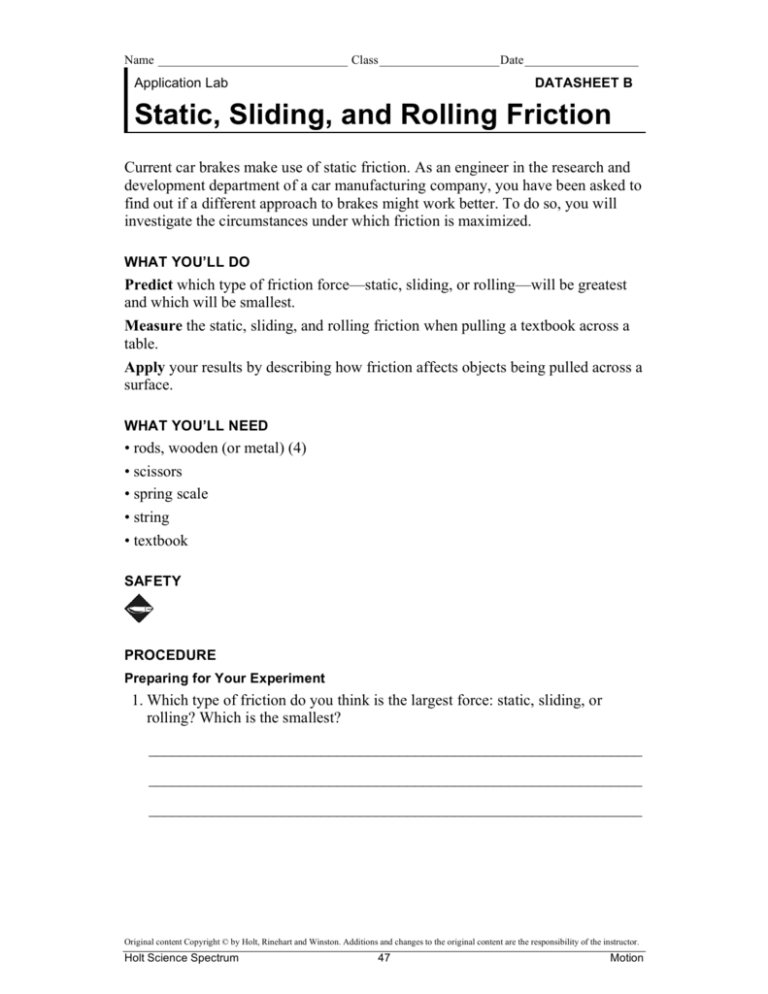Types of Friction Lab-Static,Sliding and Rolling
advertisement

Name ______________________________ Class___________________Date__________________ Application Lab DATASHEET B Static, Sliding, and Rolling Friction Current car brakes make use of static friction. As an engineer in the research and development department of a car manufacturing company, you have been asked to find out if a different approach to brakes might work better. To do so, you will investigate the circumstances under which friction is maximized. WHAT YOU’LL DO Predict which type of friction force—static, sliding, or rolling—will be greatest and which will be smallest. Measure the static, sliding, and rolling friction when pulling a textbook across a table. Apply your results by describing how friction affects objects being pulled across a surface. WHAT YOU’LL NEED • rods, wooden (or metal) (4) • scissors • spring scale • string • textbook SAFETY PROCEDURE Preparing for Your Experiment 1. Which type of friction do you think is the largest force: static, sliding, or rolling? Which is the smallest? _______________________________________________________________ _______________________________________________________________ _______________________________________________________________ Original content Copyright © by Holt, Rinehart and Winston. Additions and changes to the original content are the responsibility of the instructor. Holt Science Spectrum 47 Motion Name ______________________________ Class___________________Date__________________ Static, Sliding, and Rolling Friction continued 2. Form a hypothesis by writing a short paragraph that answers the question above. Explain your reasoning. _______________________________________________________________ _______________________________________________________________ _______________________________________________________________ _______________________________________________________________ _______________________________________________________________ 3. Use the data table below to record your results. CAUTION: Secure loose clothing, and remove dangling jewelry. Do not wear open-toed shoes or sandals in the lab. DATA TABLE: FRICTION MEASUREMENTS Static friction (N) Sliding friction (N) Rolling friction (N) Trial 1 Trial 2 Trial 3 Average of the 3 trials Collecting Data and Testing the Hypothesis 4. Cut a piece of string, and tie it in a loop that fits inside a textbook. Hook the string to the spring scale as shown. Original content Copyright © by Holt, Rinehart and Winston. Additions and changes to the original content are the responsibility of the instructor. Holt Science Spectrum 48 Motion Name ______________________________ Class___________________Date__________________ Static, Sliding, and Rolling Friction continued 5. To measure the static friction between the book and the table, pull the spring scale very slowly. Gradually increase the force with which you pull on the spring scale until the book starts to slide across the table. Pull very gently. If you pull too hard, the book will start lurching and you will not get accurate results. 6. Practice pulling the book as in step 5 several times until you can pull back smoothly. On a smooth trial, note the largest force that appears on the scale before the book starts to move. Record this result in your data table as static friction in Trial 1. 7. Repeat step 6 two more times, and record the results in your data table as Trials 2 and 3. 8. After the textbook begins to move, you can determine the sliding friction. Start pulling the book as in step 5. Once the book starts to slide, continue applying just enough force to keep the book sliding at a slow, constant speed. Practice this several times. On a smooth trial, note the force that appears on the scale as the book is sliding at a slow, constant speed. Record this force in your data table as sliding friction in Trial 1. 9. Repeat step 8 two times, and record the results as Trials 2 and 3 in your data table. 10. Place two or three rods under the textbook to act as rollers. Make sure the rods are evenly spaced. Place another rod in front of the book so that the book will roll onto it. Pull the spring scale slowly so that the book rolls across the rods at a slow, constant speed. Practice this several times, repositioning the rods each time. On a smooth trial, note the force that appears on the scale as the book is moving at a slow, constant speed. Record this force in your data table as rolling friction. 11. Repeat step 10 two times, and record the results in your data table. ANALYSIS 1. Organizing Data For each type of friction, add the results of the three trials and divide by 3 to get an average. Record these averages in your data table. 2. Analyzing Data Which of the three types of friction was the largest force, on average? _______________________________________________________________ 3. Analyzing Data Which of the three types of friction was the smallest force, on average? _______________________________________________________________ Original content Copyright © by Holt, Rinehart and Winston. Additions and changes to the original content are the responsibility of the instructor. Holt Science Spectrum 49 Motion Name ______________________________ Class___________________Date__________________ Static, Sliding, and Rolling Friction continued COMMUNICATING YOUR RESULTS 4. Drawing Conclusions Did your answers to Analysis questions 2 and 3 agree with the hypotheses you made before collecting data? If not, explain how your results differed from what you predicted. _______________________________________________________________ _______________________________________________________________ _______________________________________________________________ 5. Evaluating Methods In each trial, the force that you measured was actually the force that you were exerting on the spring scale. This force was, in turn, exerted on the book. Why could you assume that this force was equal to the force of friction in each case? _______________________________________________________________ _______________________________________________________________ _______________________________________________________________ APPLICATION If the car manufacturer that you work for wants to develop an innovative braking system, should it be based on a kind of friction different from that used in existing braking systems? Explain. Original content Copyright © by Holt, Rinehart and Winston. Additions and changes to the original content are the responsibility of the instructor. Holt Science Spectrum 50 Motion







